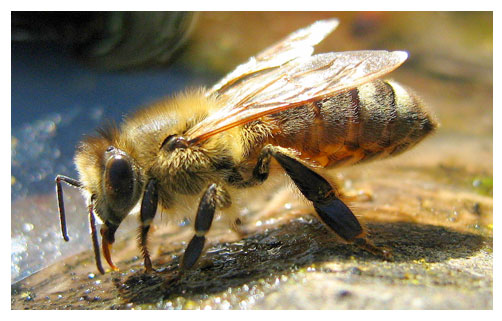



Use tweezers or a piece of cloth between your fingers to remove ticks
Place tweezers or fingers as close to the skin as possible. Pull straight back. Save the insect in a plastic bag for later identification. (If possible, ask an adult to do this--pulling a tick from your own skin can be difficult.)
Do not use tweezers or fingers to remove honeybee stingers
Honeybees have a barbed stinger and leave the stinger with the venom sac attached in the skin. It takes several minutes for the sac to inject all its venom. Removing the stinger immediately reduces harmful effects: Use the edge of a credit card to scrape the stinger away with a sideways movement (one quick scrape). Using tweezers or fingers forces more venom into the skin. For most individuals, bites are annoying, not alarming.
Keep bite sites clean to prevent infection
Wash with soap and water immediately and then several times a day. Apply antibacterial ointment. Keep your fingernails short to prevent infection caused by scratching.
Minimize itching
Itching leads to scratching. Carry an anti-itching cream and an oral antihistamine. 1% hydrocortisone ointments are effective. Generally avoid antihistamine and “-caine” ointments; these may sensitize skin. Use moisturizers, makeup, toothpaste, or shaving cream if no other anti-itching substance is available.
Apply an icepack
Cold reduces pain and prevents swelling when used promptly. Heat is effective later. Ibuprofen and acetaminophen also reduce pain and swelling.
Recognize infection
Enlarging redness and swelling around the bite a day or two later are signs of infection. Apply warm compresses frequently. If fever appears or red streaks extend from the site, seek medical attention.
Be familiar with unusual or delayed reactions
Recluse and black widow spider bites may not become symptomatic for many hours. Symptoms include pain, swelling, numbness, and hardening of the skin at the bite site. Seek medical attention promptly. Ticks may carry Lyme disease; a single "bull's eye"-type rash that occurs a week or more after the bite is an early sign of the disease. See your doctor.
Inform doctors of recent travel and outdoor activities in case of illness
Knowing that your family was overseas or in a distant national park alerts doctors to diseases not seen locally.
A small percentage of people are allergic to specific insects. Generally, the first bite sensitizes such people to that insect's venom. Subsequent bites may be life-threatening. See an allergist if you have severe or unusual reactions to bites.
![]()
Link to Dr. Karl Neumann's Web site at www.kidstraveldoc.com